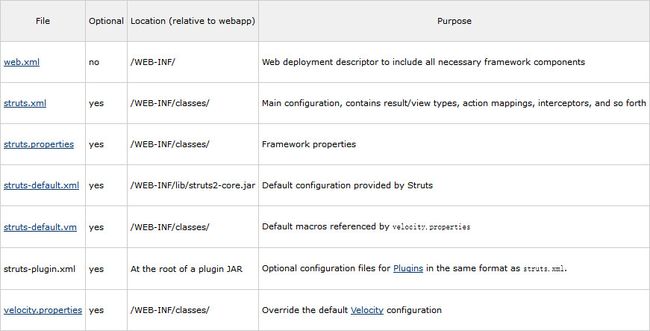我读了struts文档
Apache Struts 2 Architecture in a Nutshell
- The web browser requests a resource (/mypage.action, /reports/myreport.pdf, et cetera)
- The Filter Dispatcher looks at the request and determines the appropriate Action
- The Interceptors automatically apply common functionality to the request, like workflow, validation, and file upload handling
- The Action method executes, usually storing and/or retrieving information from a database
- The Result renders the output to the browser, be it HTML, images, PDF, or something else
Struts Configuration in a Nutshell
struts.xml配置文件:
<struts>
<package name="default" extends="struts-default">
<action name="Logon"class="mailreader2.Logon">
<result name="input">/pages/Logon.jsp</result>
<result name="cancel" type="redirectAction">Welcome</result>
<result type="redirectAction">MainMenu</result>
<result name="expired" type="chain">ChangePassword</result>
</action>
</package>
</struts>
Struts MVC in a Nutshell
Struts是一个MVC框架,框架的controller在应用的model与web界面之间充当了连接的桥。
Ajax
Struts2的标准标签库包含了一系列的Ajax JSP标签,它们可以完成很多工作,而我们只需要知道如何使用它们就行了。
Dependency Injection
依赖注入
Profiling
性能分析,可以找到软件运行时的性能瓶颈。
可以这样在配置文件中配置:
<action ... >
...
<interceptor-ref name="profiling">
<param name="profilingKey">profiling</param>
</interceptor-ref>
...
</action>
devMode
页面翻译过于缓慢,有可能是freemarker的缓存被设置为了disabled,所以应该把一些缓存设置为enable并且把一些设置为disabled,如下:
<constant name="struts.devMode" value="true" />
<constant name="struts.i18n.reload" value="false"/>
<constant name="struts.configuration.xml.reload" value="false"/>
<constant name="struts.freemarker.templatesCache" value="true"/>
<constant name="struts.freemarker.templatesCache.updateDelay" value="120"/>
<constant name="struts.freemarker.mru.max.strong.size" value="120"/>
常量配置
常量的查找是按照以下文件的顺序执行的:
1.struts-default.xml
2.struts-plugin.xml
3.struts.xml
4.struts.properties
5.web.xml
在web.xml中的常量配置如下:
<filter>
<filter-name>struts</filter-name>
<filter-class>org.apache.struts2.dispatcher.FilterDispatcher</filter-class>
<init-param>
<param-name>struts.devMode</param-name>
<param-value>true</param-value>
</init-param>
</filter>
package配置
属性:
name 必须且唯一
extends 非必须
namespace 非必须
abstract 非必须
namespace配置
如果package不指定namespace那么就是默认的namespace。
根namespace是“/”。
有如下配置:
<package name="default">
<action name="foo" class="mypackage.simpleAction">
<result name="success" type="dispatcher">greeting.jsp</result>
</action>
<action name="bar" class="mypackage.simpleAction">
<result name="success" type="dispatcher">bar1.jsp</result>
</action>
</package>
<package name="mypackage1" namespace="/">
<action name="moo" class="mypackage.simpleAction">
<result name="success" type="dispatcher">moo.jsp</result>
</action>
</package>
<package name="mypackage2" namespace="/barspace">
<action name="bar" class="mypackage.simpleAction">
<result name="success" type="dispatcher">bar2.jsp</result>
</action>
</package>
如上配置,如果请求为 /barspace/foo.action,那么会首先去barspace下寻找foo的action,如果没有找到,那么就会去执行默认的action,即name为default的package中name为foo的action。
include配置
使用标签来进行引入。被引入的文件必须与struts.xml保持一致的格式,包括DOCTYPE。
拦截器配置
拦截器:name必须唯一
拦截器栈
大多数应用需要定义一个默认的拦截器栈。
action配置
action names
在action标签中,name可以设定为带有斜杠的形式,例如,如果需要这样设置,就需要如下设置常量,。
避免在action的name中使用点(.)和横杠(-),可能会造成不必要的麻烦。
action methods
自定义action必须实现action接口,并实现execute方法。
Struts默认执行execute方法,也可以在action的配置中指定特定的方法。但是如果没有指定相应的方法,action中也没有execute方法,那么就会抛出异常。
通配符
- 可读性不强
Result
每个package都应该设置一个默认的结果类型,用于在没有指定结果时使用。如果一个package继承了另一个package,那么child package可以为其自己设置一个默认的result,当然也可以直接继承parent package的result。
Unkown Handler
Unkown Handler是实现了com.opensymphony.xwork2.UnknownHandler接口,当执行了未知的action,result或方法时被框架调用。
定义unkown handler需要在struts.xml中配置
<bean type="com.opensymphony.xwork2.UnknownHandler" name="handler" class="myclasses.SomeUnknownHandler"/>
配置多个unkown handler:
<bean type="com.opensymphony.xwork2.UnknownHandler" name="handler1" class="com.opensymphony.xwork2.config.providers.SomeUnknownHandler"/>
<bean type="com.opensymphony.xwork2.UnknownHandler" name="handler2" class="com.opensymphony.xwork2.config.providers.SomeUnknownHandler"/>
<unknown-handler-stack>
<unknown-handler-ref name="handler1" />
<unknown-handler-ref name="handler2" />
</unknown-handler-stack>
多个unkown handler将会按照unkown-handler-stack中配置的顺序执行。
Struts 配置文件
web.xml
<web-app id="WebApp_9" version="2.4" xmlns="http://java.sun.com/xml/ns/j2ee" xmlns:xsi="http://www.w3.org/2001/XMLSchema-instance" xsi:schemaLocation="http://java.sun.com/xml/ns/j2ee http://java.sun.com/xml/ns/j2ee/web-app_2_4.xsd"> <filter> <filter-name>struts2</filter-name> <filter-class>org.apache.struts2.dispatcher.ng.filter.StrutsPrepareAndExecuteFilter</filter-class> <init-param> <param-name>actionPackages</param-name> <param-value>com.mycompany.myapp.actions</param-value> </init-param> </filter> <filter-mapping> <filter-name>struts2</filter-name> <url-pattern>/*</url-pattern> </filter-mapping> <!-- ... --> </web-app>
如果需要支持应用服务器特定的文件系统,需要实现FileManager,并将其配置在web.xml中。参照DefaultFileManager.java和DefaultFileManagerFactory.java。
FileManager的配置:
<filter>
<filter-name>struts2</filter-name>
<filter-class>org.apache.struts2.dispatcher.ng.filter.StrutsPrepareAndExecuteFilter</filter-class>
<init-param>
<param-name>struts.fileManager</param-name>
<param-value>com.company.MyFileManager</param-value>
</init-param>
</filter>
FileManagerFactory的配置:
<filter>
<filter-name>struts2</filter-name>
<filter-class>org.apache.struts2.dispatcher.ng.filter.StrutsPrepareAndExecuteFilter</filter-class>
<init-param>
<param-name>struts.fileManagerFactory</param-name>
<param-value>com.company.MyFileManagerFactory</param-value>
</init-param>
</filter>
- struts.xml
- struts-default.xml:在struts.xml中继承使用。package name=”struts-default”。
应用服务器
- Jetty
- JRun
- OC4J
- Orion
- Resin
- SunOne 7.0
- JBoss 5
- WebLogic
- WebLogic 6.1
- WebSphere
- Glassfish 2.x
应用服务器的使用参照文档。
性能协调的提示与技巧
- 关闭logging和devMode
- 使用Java Templates
- 不要使用不需要的拦截器
- 使用正确的HTTP header来保证浏览器能知道如何缓存
- 在src下创建freemarker.properties,并设置template_update_delay=60000,延长模版更新扫描的时间。
- 设置struts.freemarker.templatesCache=true
- 除非需要使用到session,否则不要创建。I18nInterceptor会创建session,确保在不使用的时候移除它。
安全
- 隐藏jsp页面,将jsp页面放置于WEB-INF下
拦截器
- 在某些情况下,例如双重提交验证等,相应的拦截器会从action开始执行一直保持触发状态。
- 拦截器的执行顺序与配置的顺序一致。
struts-default下默认的result与interceptor配置:
<result-types> <result-type name="chain" class="com.opensymphony.xwork2.ActionChainResult"/> <result-type name="dispatcher" class="org.apache.struts2.dispatcher.ServletDispatcherResult" default="true"/> <result-type name="freemarker" class="org.apache.struts2.views.freemarker.FreemarkerResult"/> <result-type name="httpheader" class="org.apache.struts2.dispatcher.HttpHeaderResult"/> <result-type name="redirect" class="org.apache.struts2.dispatcher.ServletRedirectResult"/> <result-type name="redirectAction" class="org.apache.struts2.dispatcher.ServletActionRedirectResult"/> <result-type name="stream" class="org.apache.struts2.dispatcher.StreamResult"/> <result-type name="velocity" class="org.apache.struts2.dispatcher.VelocityResult"/> <result-type name="xslt" class="org.apache.struts2.views.xslt.XSLTResult"/> <result-type name="plainText" class="org.apache.struts2.dispatcher.PlainTextResult" /> <result-type name="postback" class="org.apache.struts2.dispatcher.PostbackResult" /> </result-types> <interceptor name="alias" class="com.opensymphony.xwork2.interceptor.AliasInterceptor"/> <interceptor name="autowiring" class="com.opensymphony.xwork2.spring.interceptor.ActionAutowiringInterceptor"/> <interceptor name="chain" class="com.opensymphony.xwork2.interceptor.ChainingInterceptor"/> <interceptor name="conversionError" class="org.apache.struts2.interceptor.StrutsConversionErrorInterceptor"/> <interceptor name="cookie" class="org.apache.struts2.interceptor.CookieInterceptor"/> <interceptor name="cookieProvider" class="org.apache.struts2.interceptor.CookieProviderInterceptor"/> <interceptor name="clearSession" class="org.apache.struts2.interceptor.ClearSessionInterceptor" /> <interceptor name="createSession" class="org.apache.struts2.interceptor.CreateSessionInterceptor" /> <interceptor name="debugging" class="org.apache.struts2.interceptor.debugging.DebuggingInterceptor" /> <interceptor name="execAndWait" class="org.apache.struts2.interceptor.ExecuteAndWaitInterceptor"/> <interceptor name="exception" class="com.opensymphony.xwork2.interceptor.ExceptionMappingInterceptor"/> <interceptor name="fileUpload" class="org.apache.struts2.interceptor.FileUploadInterceptor"/> <interceptor name="i18n" class="com.opensymphony.xwork2.interceptor.I18nInterceptor"/> <interceptor name="logger" class="com.opensymphony.xwork2.interceptor.LoggingInterceptor"/> <interceptor name="modelDriven" class="com.opensymphony.xwork2.interceptor.ModelDrivenInterceptor"/> <interceptor name="scopedModelDriven" class="com.opensymphony.xwork2.interceptor.ScopedModelDrivenInterceptor"/> <interceptor name="params" class="com.opensymphony.xwork2.interceptor.ParametersInterceptor"/> <interceptor name="actionMappingParams" class="org.apache.struts2.interceptor.ActionMappingParametersInteceptor"/> <interceptor name="prepare" class="com.opensymphony.xwork2.interceptor.PrepareInterceptor"/> <interceptor name="staticParams" class="com.opensymphony.xwork2.interceptor.StaticParametersInterceptor"/> <interceptor name="scope" class="org.apache.struts2.interceptor.ScopeInterceptor"/> <interceptor name="servletConfig" class="org.apache.struts2.interceptor.ServletConfigInterceptor"/> <interceptor name="timer" class="com.opensymphony.xwork2.interceptor.TimerInterceptor"/> <interceptor name="token" class="org.apache.struts2.interceptor.TokenInterceptor"/> <interceptor name="tokenSession" class="org.apache.struts2.interceptor.TokenSessionStoreInterceptor"/> <interceptor name="validation" class="org.apache.struts2.interceptor.validation.AnnotationValidationInterceptor"/> <interceptor name="workflow" class="com.opensymphony.xwork2.interceptor.DefaultWorkflowInterceptor"/> <interceptor name="store" class="org.apache.struts2.interceptor.MessageStoreInterceptor" /> <interceptor name="checkbox" class="org.apache.struts2.interceptor.CheckboxInterceptor" /> <interceptor name="datetime" class="org.apache.struts2.interceptor.DateTextFieldInterceptor" /> <interceptor name="profiling" class="org.apache.struts2.interceptor.ProfilingActivationInterceptor" /> <interceptor name="roles" class="org.apache.struts2.interceptor.RolesInterceptor" /> <interceptor name="annotationWorkflow" class="com.opensymphony.xwork2.interceptor.annotations.AnnotationWorkflowInterceptor" /> <interceptor name="multiselect" class="org.apache.struts2.interceptor.MultiselectInterceptor" /> <interceptor name="deprecation" class="org.apache.struts2.interceptor.DeprecationInterceptor" />某些默认拦截器继承了MethodFilterInterceptor,那么就可以通过传递参数(拦截action的方法名)来实现是否拦截此方法。例如:
<action name="myAction" class="myActionClass"> <interceptor-ref name="fileUpload"/> <interceptor-ref name="staticParams"/> <interceptor-ref name="params"/> <interceptor-ref name="conversionError"/> <interceptor-ref name="validation"> <param name="excludeMethods">myValidationExcudeMethod</param> </interceptor-ref> <interceptor-ref name="workflow"> <param name="excludeMethods">myWorkflowExcludeMethod</param> </interceptor-ref> </action>继承了MethodFilterInterceptor的拦截器有:
- TokenInterceptor
- TokenSessionStoreInterceptor
- DefaultWorkflowInterceptor
- ValidationInterceptor
拦截器方法:
- init
- destory
- intercept
ActionInvocation:可以通过ActionInvocation来获取到其他的action,由此可以调用其他action的方法。例如:
public class SimpleInterceptor extends AbstractInterceptor { public String intercept(ActionInvocation invocation) throws Exception { MyAction action = (MyAction)invocation.getAction(); action.setDate(new Date()); return invocation.invoke(); } }
Model Driven
Model Driven详解
Action Chain
action链可以如下配置使用:
<package name="public" extends="struts-default"> <!-- Chain creatAccount to login, using the default parameter --> <action name="createAccount" class="..."> <result type="chain">login</result> </action> <action name="login" class="..."> <!-- Chain to another namespace --> <result type="chain"> <param name="actionName">dashboard</param> <param name="namespace">/secure</param> </result> </action> </package> <package name="secure" extends="struts-default" namespace="/secure"> <action name="dashboard" class="..."> <result>dashboard.jsp</result> </action> </package>action最好只作为服务层来调用各个业务逻辑层的方法。
- ActionEventListener可以用来添加一些逻辑,当创建该action实例时或者发生异常的时候执行。
Results
PreResultListener
添加PreResultListener可以在拦截器或者action返回result之前执行一些逻辑。
action
public class MyAction extends ActionSupport { ... public String execute() throws Exception { ActionInvocation invocation = ActionContext.getContext().getActionInvocation(); invocation.addPreResultListener(new PreResultListener() { public void beforeResult(ActionInvocation invocation, String resultCode) { // perform operation necessary before Result execution } }); } ... }interceptor
public class MyInterceptor extends AbstractInterceptor { ... public String intercept(ActionInvocation invocation) throws Exception { invocation.addPreResultListener(new PreResultListener() { public void beforeResult(ActionInvocation invocation, String resultCode) { // perform operation necessary before Result execution } }); } ... }
